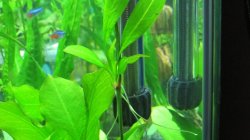There are a couple of options. The "runner" is called an inflorescence because it is a flower stalk. During the "dry" season when the plant would be emersed in its habitat, flowers develop at the nodes along the inflorescence. When grown permanently submersed, as in the aquarium, adventitious plants form at the nodes; it is very rare to see flowers, though I have once with Echinodorus major. The plant here is Echinodorus grisebachii, probably the form E. bleherae which used to be considered a distinct species but is now known to be the same species. This is the form commonly sold as "Amazon sword plant."
You can leave the adventitious plants attached to the inflorescence and they will continue to grow. Sometimes this is useful as you have plants higher in the water column. I find that in time these will develop algae, black brush particularly, and they will grow slower than when planted. Echinodorus are heavy feeders, and I suspect that they obtain fewer nutrients in the water column than they would in the substrate where we can add substrate tabs plus the closer nutrients from decomposing organics.
Another option is to remove the entire inflorescence with the adventitious plants attached, by cutting it off close to the base at the crown of the parent plant. Once the adventitious plants develop roots as shown here, they are obtaining their nutrients via their own roots and leaves from the water, not from the parent plant via the inflorescence. You can stick the inflorescence elsewhere.
The third option is to remove one or more of the adventitious plants and plant them individually in the substrate. If you take hold of the adventitious plant at the base (crown) you can gently pull it downward along the inflorescence, toward the base, and they will break off easily. You will find two individual plants at each node. Sometimes I remove just one, carefully, and leave the other.
Byron.


